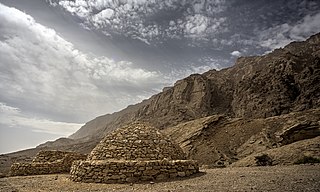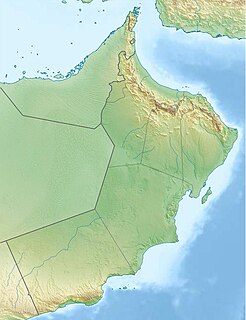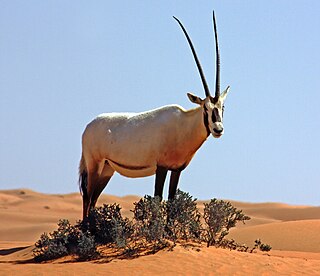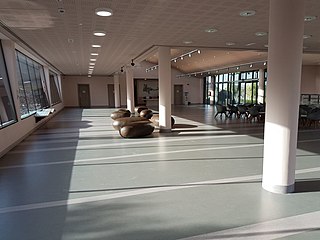Shada Mountain Reserve is a natural reserve in Saudi Arabia managed by the Saudi Wildlife Authority. [1] The reserve is home to key plant and animal species including the endangered Arabian leopard. [1]
The 68.62 km² area reserve is located in Al Baha with an altitude up to 2,222 meters above sea level. It was listed as a protected reserve in 2002. [2]
The reserve is known for the largest variety of flora in the region. [3] [4] There are approximately 500 plant species reported in this reserve. [1] [4] The Arabian leopard, one of the endangered species, is inhabiting this reserve. There are other species in this reserve including Arabian wolf, caracal, rock fox, striped hyaena and genet. [5] [1]

Jabal Hafeet is a mountain in the region of Tawam, on the border of the United Arab Emirates and Oman, which may be considered an outlier of Al Hajar Mountains in Eastern Arabia. Due to its proximity to the main Hajar range, the mountain may be considered as being part of the Hajar range, sensu lato. To the north is the UAE city of Al Ain, in the Eastern Region of the Emirate of Abu Dhabi, and the adjacent Omani town of Al-Buraimi.

The Arabian leopard is a leopard subspecies native to the Arabian Peninsula. It has been listed as Critically Endangered on the IUCN Red List since 1996 as fewer than 200 wild individuals were estimated to be alive in 2006. The population is severely fragmented. Subpopulations are isolated and not larger than 50 mature individuals. The population is thought to decline continuously.

The Arabian Peninsula coastal fog desert, also known as the Southwestern Arabian coastal xeric scrub, is desert ecoregion on the southern coasts of the Arabian Peninsula, which experiences thick fogs where visibility may be reduced to 33 feet (10 m). It is classed as an Afrotropical fog desert

Wadi Wurayah is a 12,700-hectare (31,000-acre) wadi between the towns of Masafi, Khor Fakkan and Bidiyah in the United Arab Emirates. It has been designated as Ramsar Wetland of International Importance.

The Asir Mountains is a mountainous region in southwestern Saudi Arabia running parallel to the Red Sea. It comprises areas in the 'Asir Region of Saudi Arabia, however it also generally includes areas near the Yemeni border. The mountains cover approximately 100,000 square kilometres (40,000 sq mi) and consists of mountains, plains, and valleys of the Arabian highlands. Sensu lato, they are part of the Sarawat Mountains, defining the latter as the mountain range which runs parallel to the Tihamah throughout the western portion of the Arabian Peninsula, particularly the western parts of Saudi Arabia and Yemen.

The Arabian oryx, also called the white oryx, was extinct in the wild as of 1972, but was reintroduced to the wild starting in 1982. Initial reintroduction was primarily from two herds: the "World Herd" originally started at the Phoenix Zoo in 1963 from only nine oryx and the Saudi Arabian herd started in 1986 from private collections and some "World Herd" stock by the Saudi National Wildlife Research Center (NWRC). As of 2009 there have been reintroductions in Oman, Saudi Arabia, Israel, the United Arab Emirates, and Jordan, and as of 2013 the IUCN Red List classifies the species as vulnerable.

Jabal Samhan Nature Reserve is a nature reserve in the area of Jabal Samḥān in Dhofar, Oman. It has an area of 4,500 square kilometres (1,700 sq mi) and has no permanent population. Being in the region of the Dhofar Mountains, it is one of the last refuges for wild Arabian leopards.

The wildlife of Saudi Arabia is substantial and varied. Saudi Arabia is a very large country forming the bulk of the Arabian Peninsula. It has several geographic regions, each with a diversity of plants and animals adapted to their own particular habitats. As well as high mountains and deserts, there is a coastal plain and long coastline on the Gulf of Aqaba and the Red Sea to the west and a rather shorter coastline on the Persian Gulf to the east.
Jabal Aja Protected Area is a protected area in northern Saudi Arabia. It consists of a red granite mountain range projecting from a flatter area and is of importance for both plant and animal life. It lies at 27°30'N and 41°30'E close to the town of Ha'il and has a total area of around 200,000 hectares. Jabal Aja has been designated an Important Plant Area and an Important Bird and Biodiversity Area.

The wildlife of the United Arab Emirates is the flora and fauna of this country on the eastern side of the Arabian Peninsula and the southern end of the Persian Gulf. The country offers a variety of habitats for wildlife including the coast, offshore islands, mangrove areas, mudflats, salt pans, sand and gravel plains, sand dunes, mountain slopes, wadis and rocky summits. Because the terrain is so varied, it supports a greater number of species of plants and animals than might have been expected in this relatively small country.

The wildlife of Oman is the flora and fauna of this country in the southeastern corner of the Arabian Peninsula, with coasts on the Gulf of Oman and the Arabian Sea. The climate is hot and dry, apart from the southeastern coast, and the country offers a variety of habitats for wildlife including mountains, valleys, deserts, coastal plains and sea coasts.

Al Hefaiyah Mountain Conservation Centre is a wildlife reserve and visitor centre located west of the coastal town of Kalba in the Emirate of Sharjah, the United Arab Emirates (UAE).

The Dhofar Mountains are a mountain range in the southeastern part of the Arabian Peninsula. In a broad sense, they extend from Dhofar Governorate in Oman to Hadhramaut Governorate in Yemen, and are located between the Hajar in the northern part of Oman, and the Sarawat in the western part of Yemen. Otherwise, the range in the eastern part of Yemen, particularly near Mukalla, is referred to as the "Hadhramaut".

The Shammar Mountains is a mountain range in the northwestern Saudi Arabian province of Ha'il. It includes the Ajā (أَجَا) and Salma subranges.
Raydah Natural Reserve is a 9.33 km² protected area in Saudi Arabia managed by the Saudi Wildlife Authority. The reserve situated adjacent to Asir mountains national park. It was listed as a protected area in 1989.
Majami'al-Hadb Reserve is a protected area in Saudi Arabia managed by the Saudi Wildlife Authority.
Nafud al-‘Urayq Natural Reserve is a protected area in Saudi Arabia managed by the Saudi Wildlife Authority.
Al-Khunfah Natural Reserve is a protected area in Saudi Arabia managed by the Saudi Wildlife Authority.
Al-Tubayq Natural Reserve is a protected area in Saudi Arabia managed by the Saudi Wildlife Authority.
| This Saudi Arabia related article is a stub. You can help Wikipedia by expanding it. |